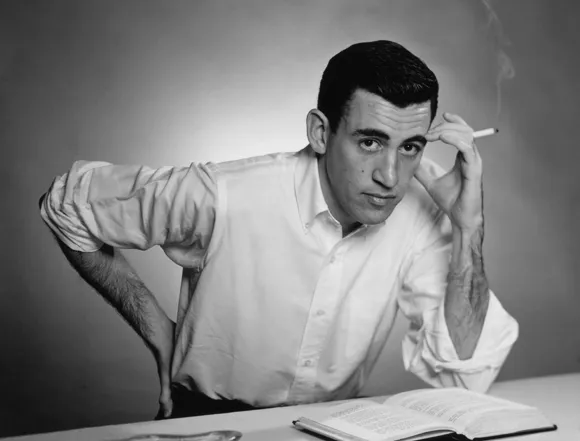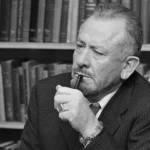Get ready to dive into the fascinating life of J.D. Salinger, the writer who’s like a puzzle wrapped in a mystery. Known for his masterpiece “The Catcher in the Rye” and his shy, secretive ways, Salinger’s world is full of surprises. We’re about to uncover the hidden corners of his life and shed light on the enigma that is J.D. Salinger.
Interesting Facts About J.D. Salinger
- Salinger Really Valued His Privacy: J.D. Salinger, the author of The Catcher in the Rye, was notoriously private. He strongly disliked the public eye and went to great lengths to shield his personal life. He even sued his biographer for publishing details about him without permission. Eventually, Salinger retreated to a quiet life in Cornish, New Hampshire, far away from the spotlight. This intense need for privacy might have stemmed from the pressures of fame and his experiences during World War II.
- The Scars of War: Speaking of the war, World War II had a profound impact on Salinger. He was drafted and witnessed the horrors of combat firsthand. Experts suggest that he likely suffered from post-traumatic stress disorder (PTSD). This experience deeply affected his writing, which often explores themes of isolation, disillusionment, and the struggles of young people trying to find their place in a confusing world.
- Hollywood Couldn’t Tempt Him: Despite numerous offers from Hollywood producers, Salinger absolutely refused to let anyone adapt The Catcher in the Rye into a movie. He was adamant that the book’s essence—its raw emotion and unique narrative voice—simply couldn’t be translated onto the big screen. This decision, while frustrating to some, cemented the novel as a pure work of literature, untouched by Hollywood glitz.
- A Legacy Built on a Few Masterpieces: While Salinger didn’t publish a ton of books, his impact on American literature is massive. The Catcher in the Rye, in particular, became a cultural phenomenon. Readers, especially young adults, connected with its timeless themes of teenage angst, rebellion, and the search for authenticity. Even today, decades later, the book continues to resonate with new generations.
- The Enigma of J.D. Salinger: There’s an air of mystery surrounding Salinger. He’s like a puzzle that scholars and readers are still trying to piece together. His complicated relationship with his daughter, Margaret, who also wrote a memoir, offers a glimpse into his views on family and estrangement. Furthermore, his interest in Vedanta, a spiritual practice rooted in Hinduism, adds another layer to his complex persona and might offer clues about the philosophical ideas he explored in his writing.
- Exploring Salinger’s Jewish Roots: Some literary scholars are now digging deeper into how Salinger’s Jewish heritage might be reflected in his work, particularly The Catcher in the Rye. This new avenue of study could provide a richer understanding of the novel’s characters, themes, and the social context in which it was written. This evolving scholarship might shed light on the layers of meaning embedded within Salinger’s iconic book.
What are Two Interesting Facts About J.D. Salinger?
We’ve already dived a bit into the life of J.D. Salinger, but let’s uncover some more intriguing tidbits about the man behind the famous Holden Caulfield.
- War Wasn’t Just a Story for Salinger: It’s pretty well-known that Salinger served in World War II, but his experiences went way beyond basic training. He saw some of the most brutal combat of the war, including the D-Day landing at Utah Beach and fighting in the Battle of the Bulge. These events weren’t just plot points for him; they deeply affected him. Historians and literary experts suggest that Salinger likely carried the weight of what he saw, probably grappling with what we now call PTSD. While we can’t say for sure how much his service directly influenced his writing, it’s hard to imagine it didn’t play a role in shaping his perspective on life, especially considering the themes of trauma and loss found in some of his work.
- Success Can Make You Want to Disappear: After “The Catcher in the Rye” exploded onto the literary scene, Salinger did the opposite of what most authors would do. He didn’t chase the spotlight, do endless interviews, or try to churn out another bestseller. Instead, he pretty much went off the grid. He retreated to his New Hampshire home and was rarely seen in public. This decision has fascinated people for decades. Some think the pressure of fame was just too much for him, while others believe he was fiercely protective of his art and didn’t want to taint it with commercialism. Whatever the reason, Salinger’s reclusiveness only adds to the mystique surrounding him and his work. It’s like he gave us this incredibly powerful story and then decided to let it speak for itself, leaving us to puzzle over the man behind the curtain.
What are Some Important Facts About The Catcher in the Rye?
We’ve already touched on some of the reasons why The Catcher in the Rye is considered such a significant work. Now, let’s dive a little deeper into the details that make this book such a fascinating piece of literary history.
One of the first things you’ll hear about The Catcher in the Rye is that it ruffled a lot of feathers when it first came out. This was 1951, a time when people weren’t as open about discussing things like teenage angst and rebellion. Salinger’s raw, honest depiction of these themes, especially through the eyes of a cynical and somewhat troubled 16-year-old, made some people really uncomfortable.
That teenager is Holden Caulfield, who has become a literary icon. Holden is a prep school dropout who’s wandering around New York City trying to figure out life. He’s disillusioned, grappling with loss and grief, and desperately trying to hold onto this idea of innocence in a world that seems determined to snatch it away.
And that’s where the book really gets you thinking – it’s not just a coming-of-age story, it’s an exploration of these universal themes of identity, belonging, and the sometimes painful journey from childhood to adulthood. It asks these really big questions about what it means to be authentic, to protect what matters to you, and to find your place in a world that often feels phony and confusing.
Even though it sparked controversy, The Catcher in the Rye became a massive success. People connected with Holden’s voice, his humor, his vulnerability. The book has been translated into over 60 languages, sold millions of copies worldwide, and is still studied in schools today, demonstrating its lasting impact.
Here are a few more interesting facts about the book:
- Published: 1951
- Setting: New York City
- Narrator: Holden Caulfield (first-person perspective)
- Length: Roughly 277 pages
There have been attempts to adapt The Catcher in the Rye for the big screen, although J.D. Salinger was notoriously private and never gave permission for a film adaptation while he was alive.
While The Catcher in the Rye remains a bit of a literary enigma, its impact on literature and its enduring exploration of the human experience are undeniable. It’s a book that continues to generate discussion, debate, and a sense of connection across generations.
What Challenges Did J.D. Salinger Face?
J.D. Salinger’s writing resonated with people, but life wasn’t always easy for him. Behind the genius and the fame, Salinger wrestled with some tough challenges that left a mark on him and his work.
Let’s explore these challenges:
- Imagine pouring your heart into your writing, only to face rejection after rejection. That was Salinger’s reality for a while, but he didn’t give up.
- Then there’s World War II. Salinger witnessed traumatic events, and it’s likely he struggled with PTSD. You can feel that experience echoing in his writing.
- Fame can be a double-edged sword. Salinger craved privacy and became a recluse, even suing people to protect his personal life and work.
- Salinger was fiercely protective of his vision, especially when it came to “The Catcher in the Rye.” He refused to let anyone make a movie adaptation because he didn’t trust them to get it right.
Let’s break down these challenges:
1. Rejection Didn’t Stop Him
Before Salinger achieved success, he faced numerous rejections from publishers. He could have easily given up, but he didn’t. He kept writing, kept improving, and eventually, the world took notice.
2. The Scars of War
World War II was a turning point for Salinger. The things he saw and experienced left deep psychological scars. Some experts believe this is why his writing often explored themes of innocence lost and the struggles of young people trying to find their place in a confusing world.
3. Fame? No Thanks!
“The Catcher in the Rye” catapulted Salinger to fame, but he became extremely private, avoiding the spotlight, and even suing people who tried to write about him or adapt his work. He valued his privacy and went to great lengths to protect it.
4. Protecting His Art
Salinger was incredibly protective of his work, especially “The Catcher in the Rye.” He saw it as his own creation, his own voice, and refused to let anyone tamper with it. He rejected every movie offer because he didn’t believe anyone could truly capture the essence of the book on screen.
Despite facing these challenges, Salinger never stopped writing, and he never compromised his artistic vision. He reminds us that even brilliant minds face struggles, and sometimes, those struggles can make the art even more powerful.
What Was J.D. Salinger Famous For?
J.D. Salinger—you’ve probably heard the name—is best known for his book “The Catcher in the Rye,” published in 1951. This wasn’t just another book; it struck a chord, especially with young readers. Salinger had a knack for getting inside the heads of teenagers, understanding their worries, frustrations, and feelings of being misunderstood. He poured all of this into “The Catcher in the Rye” through the main character, Holden Caulfield.
Being a teenager is tough, isn’t it? You’re trying to figure out who you are, where you fit in, all while dealing with the pressures of growing up. Salinger captured that feeling of alienation in a way that resonated with readers, and it still does today.
Part of what made his writing so powerful was his use of interior monologue. He wasn’t just telling you what his characters were doing; he was letting you hear their thoughts, their doubts, their dreams. It was like getting a glimpse into their souls, making them feel incredibly real.
But here’s the other thing about Salinger: he was a bit of an enigma. Despite the success of his writing, he shied away from the spotlight. Fame wasn’t his thing. He valued his privacy, and eventually, he retreated from public life altogether.
Imagine: an author who achieves literary fame but chooses to withdraw from the very world that celebrated him. It adds another layer to his legacy, doesn’t it? It makes you wonder what was going on in his brilliant mind.
And that’s the thing about J.D. Salinger – he left us wanting more. His work sparks conversations, making us think about life’s complexities, adolescence, and finding our place in the world. He may be gone, but his words, his characters, are still very much alive.
Did J.D. Salinger Serve in WWII?
Are you curious about J.D. Salinger, the author of The Catcher in the Rye, and his connection to World War II? Salinger’s time in the war significantly impacted his life and writing.
Salinger didn’t just serve in WWII, he was in the thick of it. In 1942, he was drafted into the Army and assigned to counterintelligence—a detective in a warzone. Stationed in Europe, he landed on the beaches of Normandy on D-Day! He saw some of the most intense fighting, including the Battle of the Bulge. His job involved interrogating prisoners and civilians suspected of being enemies.
Experiences like that inevitably change you. For Salinger, his wartime experiences fueled his writing. In The Catcher in the Rye, his most famous book, you can see echoes of the war – the feeling of trauma, the struggle to find meaning in a world gone crazy, the sense of being alone even when surrounded by people. It’s like the war gave him a unique perspective on what it means to be human, with all its flaws and complexities.
The war didn’t just impact his writing; it shaped Salinger as a person. After all that he witnessed, he became very private, withdrawing from the public eye to focus on his craft. Some people saw it as being reclusive, but maybe it was more than that. Maybe it was about trying to process everything he’d seen and experienced.
Even though the war ended decades ago, Salinger’s writing, with its themes of trauma, alienation, and the search for something real, still resonates with readers today. It makes you wonder: how much of ourselves do we see reflected in the stories we tell, and how much of those stories are shaped by the world around us?
Why Was Catcher in the Rye Banned?
“The Catcher in the Rye” grapples with heavy themes—teenage angst, rebellion, and sexuality. But those themes weren’t the only reasons why this book was pulled from some bookshelves.
One of the biggest issues people had was Holden Caulfield’s language and behavior. He wasn’t exactly polite. The book contains curse words and depicts teenagers drinking, which concerned parents and teachers. They worried that this kind of language and behavior wasn’t suitable for young readers and could be a bad influence.
Another concern was how the book dealt with mental health. Holden is clearly struggling – he’s depressed, alienated, and even contemplates suicide. Some feared that reading about these dark emotions might push vulnerable young people over the edge or encourage similar feelings, leading to the book being banned in several schools.
And it wasn’t just about language and mental health. “The Catcher in the Rye” also critiques society – calling out hypocrisy, materialism, and what Holden famously calls “phoniness.” Some people interpreted these criticisms as being anti-establishment, even bordering on promoting communism. This added another layer to the controversy, especially during the Cold War era when fear of communism was rampant.
The reasons for banning the book often overlapped. A school board might have cited offensive language as the main reason, while underlying concerns about the book’s potential to inspire rebellion or question authority also played a part.
The banning of “The Catcher in the Rye” exemplifies how literature can spark important conversations about difficult issues. It reminds us that what we read can challenge our perspectives and sometimes make us uncomfortable. But it also highlights the importance of open dialogue and critical thinking, especially regarding censorship and freedom of expression.
Why Did Salinger Stop Writing?
J.D. Salinger, the author of “The Catcher in the Rye,” disappeared from the writing world after achieving great success. It’s as if he climbed Mount Everest and decided to live in a cave. People have been trying to figure out why he went silent for decades.
One factor was likely Salinger’s strong belief in his work. Imagine being so sure of every comma and sentence that you refuse to let anyone change a word. That was Salinger. This led to clashes with editors. This constant battle for control over his writing might have worn him down. It’s possible he felt he couldn’t work within the system anymore and chose to walk away.
Then there’s the impact of World War II. Salinger wasn’t just behind a desk during the war; he was a counterintelligence agent who witnessed traumatic events. It’s understandable that someone who has seen so much darkness might want to retreat from the world and find peace.
And, of course, we can’t forget the phenomenal success of “The Catcher in the Rye.” Salinger became a literary superstar, and he hated it. He was a private person thrust into the spotlight. The constant attention and scrutiny probably became too much for him.
The truth is, we may never know for sure why Salinger stopped writing. It’s a question that continues to fascinate literary detectives and fans. Maybe it was a combination of these factors, or maybe it was something else entirely. What we do know is that Salinger left behind a powerful legacy with “The Catcher in the Rye.” It’s a book that still speaks to people today, exploring themes of teenage angst, disillusionment, and the search for authenticity in a world that often feels fake.
What Caused J.D. Salinger to Write Catcher in the Rye?
What inspired Salinger to write The Catcher in the Rye? It’s a puzzle with a few key pieces.
One piece is World War II. Imagine being a young man like Salinger, facing the horrors of war firsthand. It would deeply affect you. Many believe the war shook him, and some suggest it even led to PTSD. It’s no wonder that Catcher is full of disillusionment and characters feeling lost, reflecting the sentiment many probably felt after the war.
Then there’s Salinger’s personality. He couldn’t stand fakeness. He saw it everywhere and wanted to scream. You can almost hear him yelling through Holden Caulfield, the main character in Catcher. Holden is a rebellious teenager who despises phoniness, much like Salinger himself.
But it wasn’t just about hating the negative. Salinger seemed to yearn for something real, something genuine. He wanted to find a connection, a place where innocence wasn’t lost. Think about Holden’s journey in the book; he’s desperately searching for that authenticity, for a world that isn’t messed up. It’s like Salinger poured his own longing into Holden’s story.
Salinger seemed to understand teenagers. It’s like he could crawl inside their heads and grasp their messy emotions, confusion, and frustration with growing up. Catcher captures that feeling of being stuck between childhood and adulthood, that awkward “in-between” stage.
These are just some of the likely reasons behind Salinger’s book. It’s impossible to know for sure what went on in his head. By looking at his life, his experiences, and his personality, we can try to piece together what might have driven him to write such a powerful and enduring novel.
What are the Two Most Important Ideas in Catcher in the Rye?
Holden Caulfield, the main character in The Catcher in the Rye, despises “phonies.” He sees them everywhere – in the way people act, the things they say, even in the books they read. This hatred of all things fake is central to the book and suggests one of its most important ideas: being true to yourself matters. Holden’s journey, messy as it is, reminds us that figuring out who we are and what we believe in is crucial, even if it means going against the grain.
But Holden’s story isn’t just about calling out fakeness. He’s also deeply confused about who he is and where he fits in the world. He bounces from school to school, struggles to connect with people, and seems lost in his own thoughts. Experts believe this struggle points to another major theme in the novel: the universal challenge of finding your identity. Holden’s experiences, though often extreme, resonate with the ups and downs many of us face as we try to find our place in the world.
While The Catcher in the Rye offers these key takeaways, remember that literature’s beauty lies in its open-ended nature. Ongoing research and diverse interpretations continue to enrich our understanding of this complex novel. So, while we can certainly identify these central themes, the exploration of their nuances and implications remains an evolving discussion.
Why is Catcher in the Rye Unique?
We’ve discussed what makes “The Catcher in the Rye” captivating, but what truly sets it apart in the literary world?
One factor is how J.D. Salinger captures the essence of being a teenager. Holden Caulfield, the main character, has become an iconic symbol of the feeling of being lost and confused while trying to figure out who you are in a world that often feels fake. Holden’s journey, the way he bumps up against the adult world and finds it wanting, resonates with readers across generations. It’s like he’s holding up a mirror to the awkwardness and uncertainty of growing up.
And Salinger’s writing style! He doesn’t shy away from the raw, sometimes messy thoughts and feelings of a teenager. Holden’s voice, the way he tells the story, feels so real and honest. It’s like you’re right there with him, experiencing his world firsthand, which makes the novel incredibly relatable, even if you didn’t grow up in the same period.
“The Catcher in the Rye” continues to resonate with young readers today. It’s like this book, written decades ago, still understands the struggles and anxieties of being a teenager in today’s world. It offers comfort, a sense that someone gets it, while also pushing readers to think critically about the world around them.
People are still talking about “The Catcher in the Rye” for a reason. It’s more than just a coming-of-age story; it’s a timeless exploration of what it means to be human, to grapple with disillusionment, and to search for authenticity in a world that often feels superficial.
Interested in exploring other intriguing figures?
Get the scoop on the enigmatic Barbara McClintock and her groundbreaking work in genetics: interesting facts about Barbara McClintock
Discover the tormented mind behind “The Scream.” Delve into the intriguing life and artistic genius of Edvard Munch: interesting facts about Edvard Munch.
Prepare to be enchanted by the romantic melodies of Frederic Chopin. Explore the fascinating details and untold stories from his life: interesting facts about Frederic Chopin











